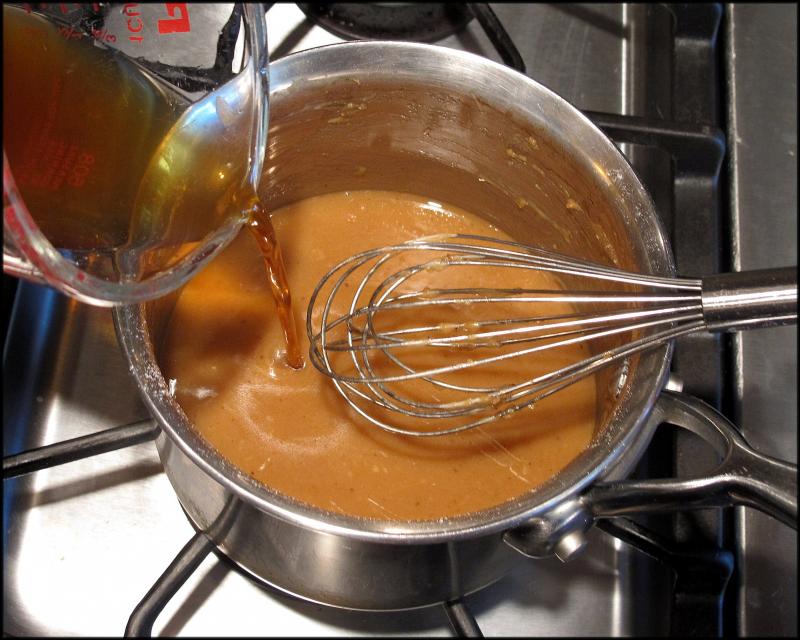Good gravy: Secret’s in the sauce
Many people have told me they find it difficult to make good gravy, especially for holiday meals. Perhaps because there are lots of guests, more menu items than usual and a rush at the last minute to get everything on the table. When serving multiple courses and dozens of dishes to a large group of people, there’s lots of pressure for everything to be ready at the same time, which often leaves gravy as the final hassle.
By way of definition, gravy is a sauce made from the juices and browned bits (called fond) left in the pan once you’ve cooked your fish filets, lamb chops, beef steak or roast turkey. A chemical transformation of the proteins, through a process known as the Maillard reaction, is responsible for the fond - rich morsels of concentrated flavor which are the basic building blocks of wonderful gravy.
There are just a few ingredients in gravy: fond, liquid and a thickening agent. To begin your gravy, you’ll need to deglaze the pan to release and dissolve the fond into your liquid. The easiest way to do this is to set your roasting pan on the stove over medium heat and pour in a generous splash of wine or stock. Stir the mixture while scraping up the browned bits to incorporate them into the liquid.
What you have now is a highly flavored but very thin liquid, which could serve as a delicious “au jus.” The next step is to thicken your gravy, and the best way to do that is with a roux. For those of you unfamiliar with the term, a roux is a mixture of equal parts fat (usually butter) and flour, cooked into a paste. The benefit of using a roux is that you will avoid a pasty flavor from uncooked flour.
A roux is the hallmark of many Southern soups and stews, adding deep color and rich flavor to gumbos and étouffées.
The longer you cook a roux, the darker its brown color becomes. Back to the gravy in question, you can make your roux well before you start to roast the bird and have it on hand when you’re ready to deglaze the roasting pan. Another trick is to lightly brown the flour in a dry skillet as a shortcut to more color and better flavor.
Since nothing is foolproof against lumps and most of us object to lumpy gravy, there’s a simple way to prevent them - use a strainer.
Once you’ve deglazed the roasting pan, pour the liquid into a small saucepan through a fine-mesh strainer which should catch any burned bits of fond that haven’t dissolved. Then whisk it with the roux to thicken the mixture.
Usually, I am overly generous with roux (since I love the silky texture and buttery flavor it adds), so my gravy will need some additional stock or broth to reach the desired consistency. In the photo you can see me adding more liquid to the gravy. While you can use any type of stock or broth at this step, I prefer vegetable stock for its more complex flavor.
Some people like to add extra salt and pepper to their gravy, but I’d recommend a taste test first, since when you deglazed the pan you also picked up any seasonings you sprinkled on the bird before it cooked. I’ve also spoken with folks who have a tradition of adding “secret ingredients” to their gravy, typically sharp flavors like tabasco, Worcestershire or soy sauce. You may want to experiment before the big day.
Once you’ve tried this simple approach, I think you’ll agree the basics of good gravy are easy to master. Happy Turkey Day!
Turkey Gravy
2 T flour
2 T unsalted butter
3/4 C dry white wine
1 1/2 C broth
salt and pepper, to taste
Toast the flour in a dry skillet over low heat until lightly golden brown; remove from heat. Melt butter in a small saucepan over medium-low.
Add toasted flour and stir to combine. Cook, stirring often, until the roux is a rich golden brown; set aside until ready to make the gravy. Once the turkey is done, remove it to a carving board and tent loosely with aluminum foil. Place the roasting pan on the stove over medium heat.
Pour in the wine and begin scraping the browned bits from the bottom of the pan. Continue stirring until the solids are dissolved. Return the saucepan with the roux to the stove and pour in the wine mixture through a strainer. Over medium heat, whisk together until combined.
Add the broth and continue to cook, stirring continuously until smooth. Season to taste with salt and pepper; keep warm over very low heat. Yield: 2 C gravy.
















































